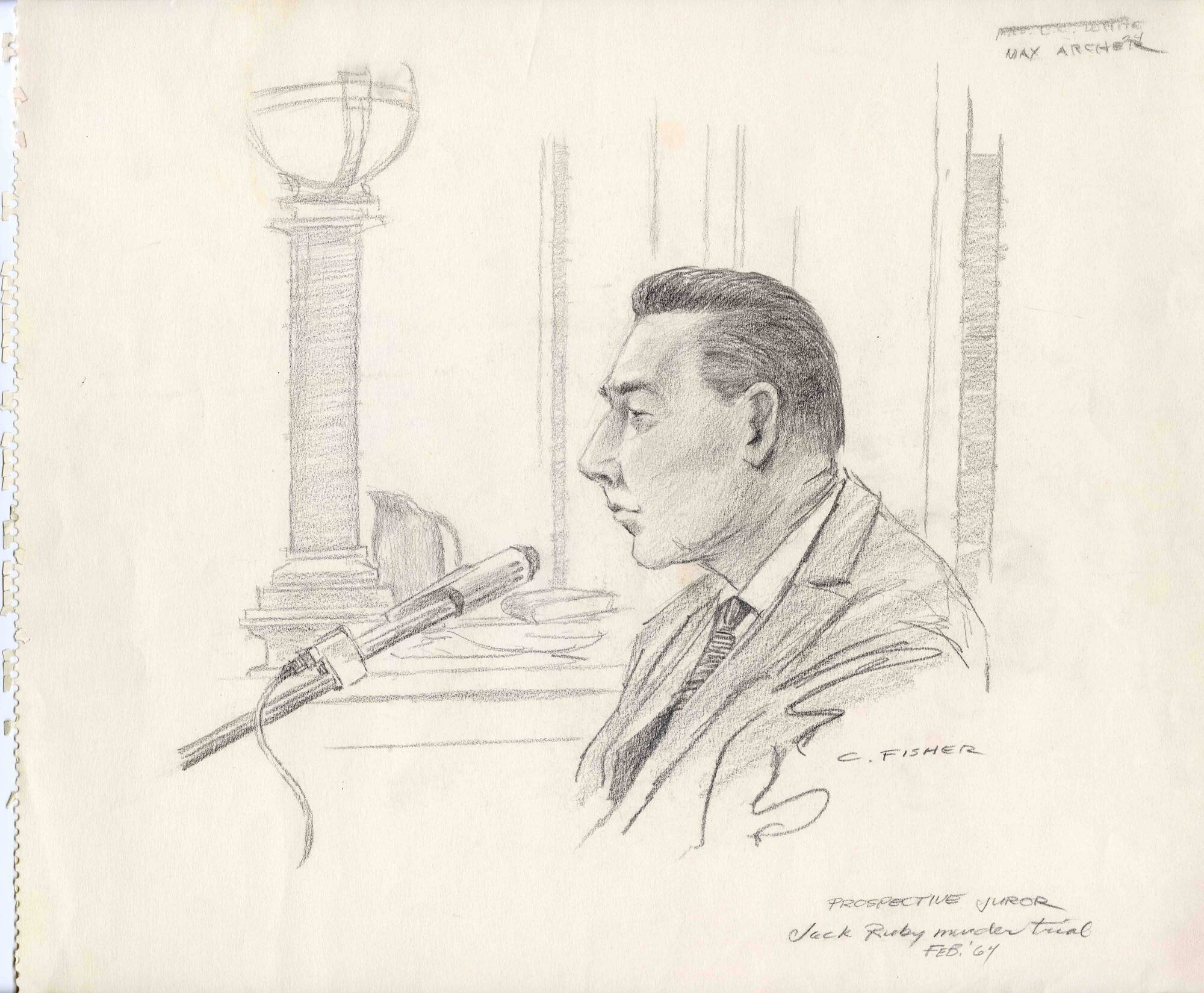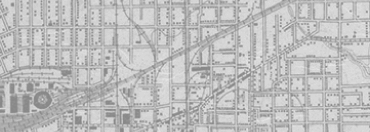


Back
Courtroom sketch of Prospective Juror Max Archer dated February 1964
Courtroom pencil sketch on paper by Charles Fisher. The sketch shows prospective juror Max Archer during the trial of Jack Ruby in February of 1964. The sketch shows the figure seated at the witness stand wearing a suit. The figure is depicted in profile, and a microphone is positioned in front of him. The caption in the bottom right reads "Prospective juror - Jack Ruby Murder Trial, Feb. '64," and an additional caption in the top right reads "Max Archer."The artist's signature: "C. Fisher" is at bottom right, underneath the figure. Charles "Chuck" Fisher was the art director at KRLD-TV in 1963. Fisher made the pencil sketches during the trial of Jack Ruby for KRLD-TV after the judge barred cameras from the courtroom.
Courtroom sketch of Prospective Juror Max Archer dated February 1964
February 1964
Paper
14 x 16 3/4 in. (35.6 x 42.5 cm)
Charles Fisher Collection/The Sixth Floor Museum at Dealey Plaza
1997.053.0009
Max Archer was the last of fourteen prospective jurors interviewed on February 26, 1964. By far, this was the most productive day of jury selection in the Ruby trial since three jurors were selected that day: R.J. Fletchner, Gwen English, and J.G. Holton. According to his testimony, Max Archer was a forty-two-year-old electrician at the Mosher Steel Company in Dallas. At the conclusion of his testimony, he was accepted as a juror by the State but challenged by the defense. -- Stephen Fagin, Curator
Jury selection in the Jack Ruby trial took place between February 17 and March 3, 1964. During that two-week period, 162 prospective jurors were interviewed, which District Attorney Henry Wade informed the news media was not a Dallas County record. Of the 162 individuals interviewed for the Ruby trial, twelve were accepted, eighteen were challenged by the defense team, eleven were challenged by the prosecution, sixty-two were ruled out because they were against the death penalty, fifty-eight were ruled out because they held fixed opinions on the case, and one was excused due to illness. -- Stephen Fagin, Curator

Courtroom sketch of Prospective Juror Max Archer dated February 1964
Courtroom pencil sketch on paper by Charles Fisher. The sketch shows prospective juror Max Archer during the trial of Jack Ruby in February of 1964. The sketch shows the figure seated at the witness stand wearing a suit. The figure is depicted in profile, and a microphone is positioned in front of him. The caption in the bottom right reads "Prospective juror - Jack Ruby Murder Trial, Feb. '64," and an additional caption in the top right reads "Max Archer."The artist's signature: "C. Fisher" is at bottom right, underneath the figure. Charles "Chuck" Fisher was the art director at KRLD-TV in 1963. Fisher made the pencil sketches during the trial of Jack Ruby for KRLD-TV after the judge barred cameras from the courtroom.
Courtroom sketch of Prospective Juror Max Archer dated February 1964
February 1964
Artist
Artwork
Sketches
Trials
Jack Ruby trial
Jury
Fisher, Charles
KRLD-TV
Dallas
Paper
14 x 16 3/4 in. (35.6 x 42.5 cm)
Charles Fisher Collection/The Sixth Floor Museum at Dealey Plaza
1997.053.0009
Max Archer was the last of fourteen prospective jurors interviewed on February 26, 1964. By far, this was the most productive day of jury selection in the Ruby trial since three jurors were selected that day: R.J. Fletchner, Gwen English, and J.G. Holton. According to his testimony, Max Archer was a forty-two-year-old electrician at the Mosher Steel Company in Dallas. At the conclusion of his testimony, he was accepted as a juror by the State but challenged by the defense. -- Stephen Fagin, Curator
Jury selection in the Jack Ruby trial took place between February 17 and March 3, 1964. During that two-week period, 162 prospective jurors were interviewed, which District Attorney Henry Wade informed the news media was not a Dallas County record. Of the 162 individuals interviewed for the Ruby trial, twelve were accepted, eighteen were challenged by the defense team, eleven were challenged by the prosecution, sixty-two were ruled out because they were against the death penalty, fifty-eight were ruled out because they held fixed opinions on the case, and one was excused due to illness. -- Stephen Fagin, Curator










